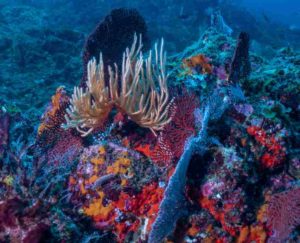One major argument for the conservation of species is the importance of biodiversity in developing new medications for treating human disease. Today, more than 50% of marketed drugs are extracted from natural sources or produced using natural products as the starting materials of synthesis. Here in Coiba National Park, a tiny cyanobacteria, or blue-green algae species, has been discovered to produce a chemical that has proven to be a potentially powerful anti-cancer agent.
Marine plants, microbes, and animals produce a wide variety of compounds for their own use in defense against predators or competitors or for use in chemical communication. Many of these compounds have pharmaceutical potential, and quite a few are in use today as the basis of vital anti-cancer and anti-viral medications. With more than 200,000 discovered species of invertebrates and algae alone in the ocean, the marine environment is a source of incredible chemical diversity.
In our very own Coiba National Park, a species of Panamanian cyanobacteria was collected and discovered to produce a compound that appears to have potent anti-cancer properties. In 2008, Dr . Kerry McPhail of Oregon State University, while scuba diving in Coiba National Park, collected blue-green algae, or cyanobacteria, for study. From this original specimen, scientists have extracted a compound being called coibamide A, and in screenings and research have found that it has a unique ability as an anti-cancer compound, working through a mechanism not yet present in existing cancer medications.
Even more exciting is coibamide A’s success during screenings in targeting and killing the cancer cells of glioblastomas, brain tumors that still have very few treatment options in existence, as they grow rapidly and aren’t very responsive to chemotherapy drugs. It has also been shown to kill off the cells of triple negative breast cancer tumors, another type of cancer that is still very difficult to treat.
Coibamide A is now continuing to be studied as scientists attempt to better understand how it works, how it could be produced synthetically, and whether it could be developed into a new anti-cancer pharmaceutical.
With so many species of marine bacteria and other organisms still undiscovered and undescribed, the biodiversity of our oceans may have the potential to unlock the secrets to treating many of the diseases that we find the most devastating today.
By Daryll Carlson
Sources:

